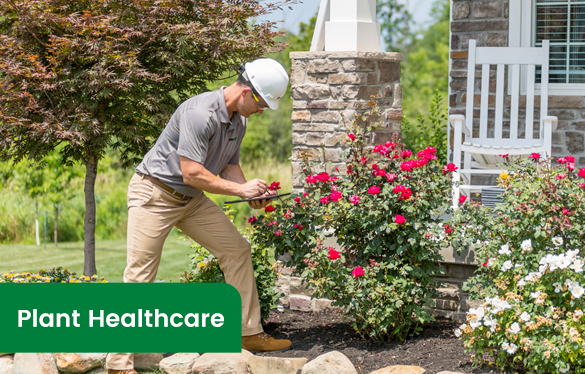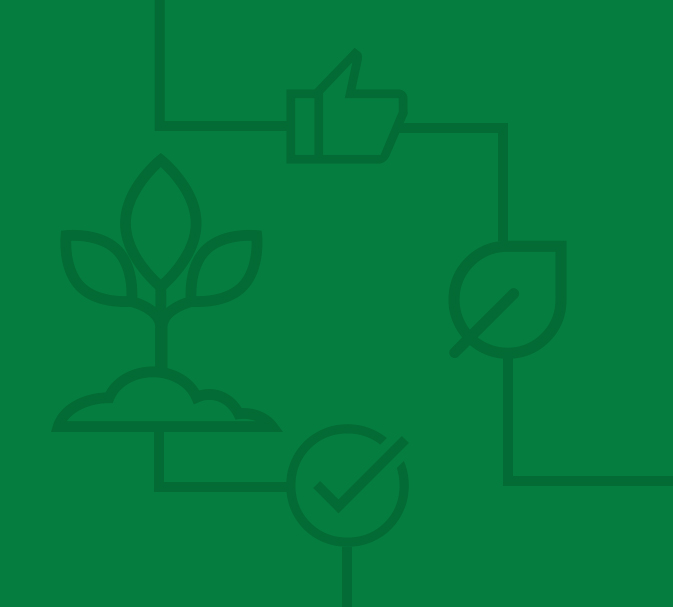Plant Healthcare Services
Maier Tree & Lawn has tree and lawn care programs that can help maintain your landscape. We also have the products and expertise to treat and eliminate unwanted pests that can damage and kill your trees and shrubs.
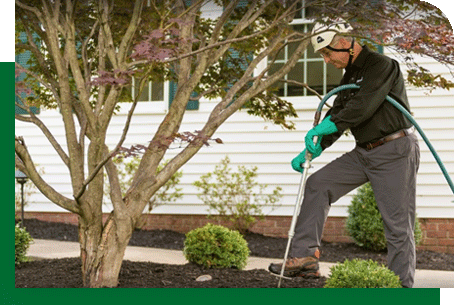
The Dangers of Insects and Diseases
Insects
Tree-destroying insects often find and infect trees that are already diseased or otherwise stressed. There are three main categories of insects that can infect your trees:
Sucking insects / Chewing insects / Boring insects
Sucking insects are equipped with mouthparts that allow them to pierce into plant tissues and then suck nutritional fluids from the plant. Depending on the particular species of insect, they can pass along toxic substances or disease-carrying pathogens that can damage or kill the host plant. Generally, shrubs and ornamental trees fall victim to sucking insects.
Chewing insects have powerful, sharp jaws, and they love to chew on leaves, flowers, and roots. This chewing action creates wounds that can allow for the introduction of other diseases. With proper treatment, chewing insects can be eradicated and the tree can recover, but you need to protect the tree from repeated infestations. Pines and spruces can fall victim to chewing insects like beetles and moths.
Boring insects lay their eggs on a suitable host tree, which, in most cases, is already diseased or under some type of stress. Once hatched, the larvae tunnel (bore) their way beneath the tree bark, where they’re basically impervious to predators and spray-type insecticide applications. As they continue to feed and grow, their tunneling seriously damages or destroys the tissues that conduct water and sap, starving the tree of required nutrients. Birch, oak, and ash trees can become victims of borers.
As noted above, insects often feed on stressed trees. The additional stress of an insect infestation can, in many cases, be the final blow that kills the tree. One solution to keeping your trees from becoming stressed and potential hosts is by ensuring they’re properly watered and nourished. The certified arborists at Maier Tree & Lawn can help keep your trees healthy and insect-free.
What is a crucial concern when planting a tree or shrub?
ENSURE IT IS PLANTED AT THE PROPER DEPTH
Disease
Just like with humans, when a tree becomes stressed, it becomes more susceptible to disease. Stress on a tree can come from many different environmental factors. Drought, overcrowding, and any damage to the stems or root system of a tree can cause stress. Stress can and does create weaknesses, allowing pathogens and disease to enter into the tree system. The most common types of tree diseases are foliage, stem, or root diseases.
Foliage diseases are often fungal diseases that grow on and infect the leaves of trees. Many times, these diseases aren’t lethal and are mostly just unsightly. After the leaves drop in the fall, proper cleanup and disposal of fallen leaves can help prevent reinfection the following spring.
Stem diseases are also generally fungal diseases. These diseases find their way into the vascular system of the tree, often resulting in the death of the crown of the limb or the entire tree. Removing an infected limb may prevent the disease from spreading.
Root diseases also fall within the fungal disease category. These diseases are generally the most lethal because they affect the tree’s ability to absorb water from the soil. As the roots become infected, they become weak, leaving the tree susceptible to falling over.
Unfortunately, diseases are often quick killers, especially in elms and oaks. Maintaining a tree’s environment and ensuring they don’t become stressed can and will greatly reduce the likelihood of infection. Knowing how to prevent tree disease is the best treatment, and the certified arborists at Maier Tree & Lawn are experts in knowing how to keep your tree healthy.
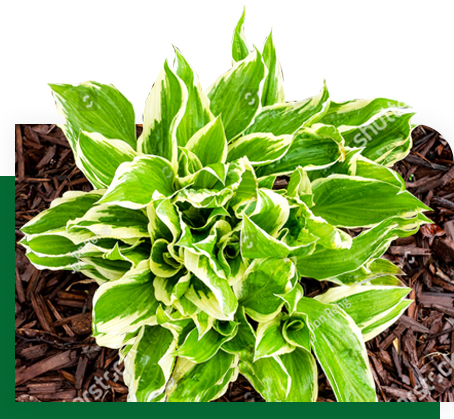
For more questions on our fertilization program, contact Maier Tree & Lawn today. We’re ready to provide you with the best root and tree care services in Rochester, Winona, and throughout Southeast Minnesota.
Maier Tree & Lawn offers services to address insect infestations, plant diseases, and soil compaction.
Soil Enrichment: Adds several important ingredients to the soil via soil injection under the entire drip-line and beyond. The addition of beneficial soil organisms, organic matter, and nutrients helps to decompact, replenish, and condition the soil for optimal root growth.
Learn more about our Root Care Program
Plant Growth Regulator: A soil-applied product that is absorbed through the roots. It gently slows the growth of a tree, allowing it to redirect some of its energy from its canopy to defense chemicals, fibrous root growth, and other uses. It is used to control growth, help roots compete in turf and compacted soils, and re-establish roots after being damaged. It is often used before and after construction and when fighting chlorosis on high-value trees and trees in small spaces.
Nutrient Injection (Iron & Manganese): Treats a condition called chlorosis. Chlorosis is a serious condition where a tree’s ability to manufacture chlorophyll has been compromised. Without sufficient chlorophyll a tree cannot make food for itself. These injections stimulate the production of chlorophyll by adding iron or manganese. Best practices include using nutrient injections with a plant growth regulator to further address issues.
Insect Treatments: We can utilize a broad-spectrum, systemic insecticide that insects ingest so they quickly stop feeding and die. These products work on many insects, including Japanese beetles, aphids, leafminers, pine tip moth, sawfly larvae, scale insects (soft scales), borers (including bronze birch borer and emerald ash borer), and more.
Fungicide for Oak Wilt: Oak wilt can be successfully managed with a fungicide. Oak wilt is a deadly root and insect-transmitted fungus that affects several species of oak. Through the use of the proper fungicide, preventative steps can be taken to protect oaks from the disease and even cure certain species that already have it.
Fungicide for Dutch Elm Disease: Dutch elm disease is a deadly fungus spread by root grafts and several types of beetles that affects many of the elm tree species found throughout Minnesota.
Through the proper use of an appropriate fungicide, most elms can be protected from getting the disease. When dealing with elms in a wooded area, we are limited in what we can do, but it is still worth it to contact us to learn your options.
Air Spade: A tool we use to safely remove soil around a root system. We may use an air spade to check for stem girdling roots or decay around the stem and root plate, or we can safely remove or stir up larger volumes of compacted soil to amend and replace. The process of root enhancement is a service we provide to do that specifically. It is a tremendous tool in keeping trees healthy.
Fertilization and Root Care in Rochester and Winona, MN
Maier Tree & Lawn has the certification and expertise required to promote tree health, including proper preventative maintenance and fertilization. We have extensive knowledge about insects and diseases that can affect trees and shrubs. Our emphasis on focusing on plant health to help avoid problems plays just as crucial a role as providing treatment remedies.
At Maier Tree & Lawn, our fertilization program addresses the source of potential problems with your trees and shrubs. The two greatest stresses on urban trees are soil compaction and water stress, and using fertilizer can actually intensify these stressors. With our root care program, however, these problems can be solved.
Urban soils are often compacted. This makes it difficult for water and oxygen to get to the tree root zone (3 to 18 inches deep). When roots don’t have room to grow, trees and shrubs miss opportunities to absorb water and nutrients. They become drought stressed, undernourished, and susceptible to many other secondary problems.
The Fertilization Program
Our fertilization program adds several important ingredients to the soil to help combat soil compaction and water stress. By making sure the tree can access the nutrients it needs, we ensure that your entire landscape’s ecosystem will stay healthy and efficient.
The biochar fertilization system is a newer technique that offers state-of-the-art help for your soil. There are many common conditions in landscape soil that are often unhealthy. Landscape soil that is unhealthy usually has low organic matter, less microbial life, poor soil structure that has compaction, and lower water and nutrient retention. Properly balanced and available nutrients are required for healthy trees and landscapes.
Biochar is an organic matter that is created by heating recycled wood waste under low oxygen conditions. The final product can be stored in the ground for decades. Biochar holds open the pores of the soil, allowing air, water, and nutrients to enter the soil, making the soil more optimal.
Holding open the pores of the soil also makes the soil more resistant to compaction. This reduces the chances of the soil decaying or compacting over time and allows it to maintain its nutrients. This will allow your trees and landscaping to prosper for years to come.
Reach out to a certified arborist at Maier Tree & Lawn today to ask about the biochar fertilization system.
Davey's advanced tree fertilization
Davey Arbor Green PRO® is the most significant advancement in tree fertilization since the original Arbor Green® was patented in 1978. Comprised of the highest-quality nutrients, including synthesized organic nitrogen fortified with polyamino acids, Davey Arbor Green PRO is formulated in just the right ratio to maximize the nutrient's effect. Davey Arbor Green PRO offers more value per dollar than any other complete formulation on the market.
Why choose Davey Arbor
Green PRO®?
Davey Arbor Green PRO contains high-quality nitrogen, potassium formulated from ureaform and monopotassium phosphate, plus polyamino acid.
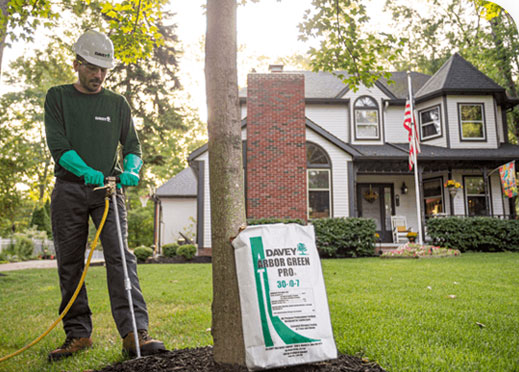
Davey Arbor Green PRO releases high-quality nutrients, including synthesized organic nitrogen fortified with polyamino acids, throughout the growing season. A slower, controlled release rate leads to uniform growth, a lower risk of leaching, and greater efficiency of nutrient absorption.
Scientists at The Davey Institute developed Davey Arbor Green PRO to maximize nutrients' effects on plants and keep trees and shrubs healthier. The technology of Davey Arbor Green PRO is intended to mimic the natural availability of nutrients in the forest environment. Davey Arbor Green PRO's low salt index allows the most sensitive trees, such as those that are drought-stressed or recently transplanted, to be fertilized.
Products like Davey Arbor Green PRO are examples of the next-generation tools being developed by Davey to serve municipalities, parks, businesses, and homeowners. By nurturing and protecting their trees and landscapes, these products can enhance the value of their properties and the overall health of their communities.
We physically and chemically amend the soil to make it better suited for mycorrhizal fungi and other beneficial soil organisms. Mycorrhizae increase a plant’s ability to absorb water and nutrients and help to decompress soil by clumping soil particles. It also banks slow-release nutrients into the soil. These substances have been shown to enhance the effectiveness of tree roots in their ability to absorb water and nutrients.
Our strategy for improving root development comes through our soil injection method of applying fertilizer. We don’t just inject fertilizer near the trunk of your tree. Rather, we inject fertilizer throughout the root zone under the canopy of the tree. This allows the maximum effect on the health and growth of your tree’s roots.
For more questions on our fertilization program, contact Maier Tree & Lawn today. We’re ready to provide you with the best root and tree care services in Rochester, Winona, and throughout Southeast Minnesota.
Tree Health Care/Pruning for Long-Term Structure
When it comes to the above-ground parts of a young tree, we rely on a process called structural or formative pruning. This is done by the reduction or removal of any branches competing with the dominant leader and any lateral limbs that are more than 1/3 the diameter of the main stem.
For more information, call our office at (507) 286-8733 to talk to one of our Certified Arborists.
PHOTO GALLERY
Tree Care
View GalleryLawn Care
View GalleryLandscaping
View GalleryPlant Heathcare
View Gallery